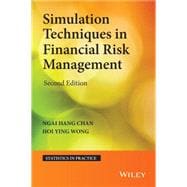Praise for the First Edition
“…a nice, self-contained introduction to simulation and computational techniques in finance…”
– Mathematical Reviews
Simulation Techniques in Financial Risk Management, Second Edition takes a unique approach to the field of simulations by focusing on techniques necessary in the fields of finance and risk management. Thoroughly updated, the new edition expands on several key topics in these areas and presents many of the recent innovations in simulations and risk management, such as advanced option pricing models beyond the Black–Scholes paradigm, interest rate models, MCMC methods including stochastic volatility models simulations, model assets and model-free properties, jump diffusion, and state space modeling. The Second Edition also features:
- Updates to primary software used throughout the book, Microsoft Office® Excel® VBA
- New topical coverage on multiple assets, model-free properties, and related models
- More than 300 exercises at the end of each chapter, with select answers in the appendix, to help readers apply new concepts and test their understanding
- Extensive use of examples to illustrate how to use simulation techniques in risk management
- Practical case studies, such as the pricing of exotic options; simulations of Greeks in hedging; and the use of Bayesian ideas to assess the impact of jumps, so readers can reproduce the results of the studies
- A related website with additional solutions to problems within the book as well as Excel VBA and S-Plus computer code for many of the examples within the book
Simulation Techniques in Financial Risk Management, Second Edition is an invaluable resource for risk managers in the financial and actuarial industries as well as a useful reference for readers interested in learning how to better gauge risk and make more informed decisions. The book is also ideal for upper-undergraduate and graduate-level courses in simulation and risk management.








